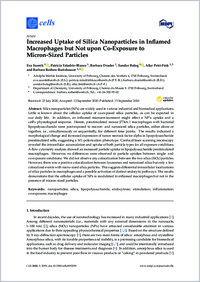Increased Uptake of Silica Nanoparticles in Inflamed Macrophages but Not upon Co-Exposure to Micron-Sized Particles.
- Susnik E Adolphe Merkle Institute, University of Fribourg, Chemin des Verdiers 4, 1700 Fribourg, Switzerland.
- Taladriz-Blanco P Adolphe Merkle Institute, University of Fribourg, Chemin des Verdiers 4, 1700 Fribourg, Switzerland.
- Drasler B Adolphe Merkle Institute, University of Fribourg, Chemin des Verdiers 4, 1700 Fribourg, Switzerland.
- Balog S Adolphe Merkle Institute, University of Fribourg, Chemin des Verdiers 4, 1700 Fribourg, Switzerland.
- Petri-Fink A Adolphe Merkle Institute, University of Fribourg, Chemin des Verdiers 4, 1700 Fribourg, Switzerland.
- Rothen-Rutishauser B Adolphe Merkle Institute, University of Fribourg, Chemin des Verdiers 4, 1700 Fribourg, Switzerland.
- 2020-09-18
Published in:
- Cells. - 2020
co-exposure
endocytosis
inflammation
lipopolysaccharide
macrophages
nanoparticles
silica
stimulation
English
Silica nanoparticles (NPs) are widely used in various industrial and biomedical applications. Little is known about the cellular uptake of co-exposed silica particles, as can be expected in our daily life. In addition, an inflamed microenvironment might affect a NP's uptake and a cell's physiological response. Herein, prestimulated mouse J774A.1 macrophages with bacterial lipopolysaccharide were post-exposed to micron- and nanosized silica particles, either alone or together, i.e., simultaneously or sequentially, for different time points. The results indicated a morphological change and increased expression of tumor necrosis factor alpha in lipopolysaccharide prestimulated cells, suggesting a M1-polarization phenotype. Confocal laser scanning microscopy revealed the intracellular accumulation and uptake of both particle types for all exposure conditions. A flow cytometry analysis showed an increased particle uptake in lipopolysaccharide prestimulated macrophages. However, no differences were observed in particle uptakes between single- and co-exposure conditions. We did not observe any colocalization between the two silica (SiO2) particles. However, there was a positive colocalization between lysosomes and nanosized silica but only a few colocalized events with micro-sized silica particles. This suggests differential intracellular localizations of silica particles in macrophages and a possible activation of distinct endocytic pathways. The results demonstrate that the cellular uptake of NPs is modulated in inflamed macrophages but not in the presence of micron-sized particles.
- Language
-
- English
- Open access status
- gold
- Identifiers
-
- DOI 10.3390/cells9092099
- PMID 32942641
- Persistent URL
- https://folia.unifr.ch/global/documents/282744
Statistics
Document views: 14
File downloads:
- fulltext.pdf: 0
